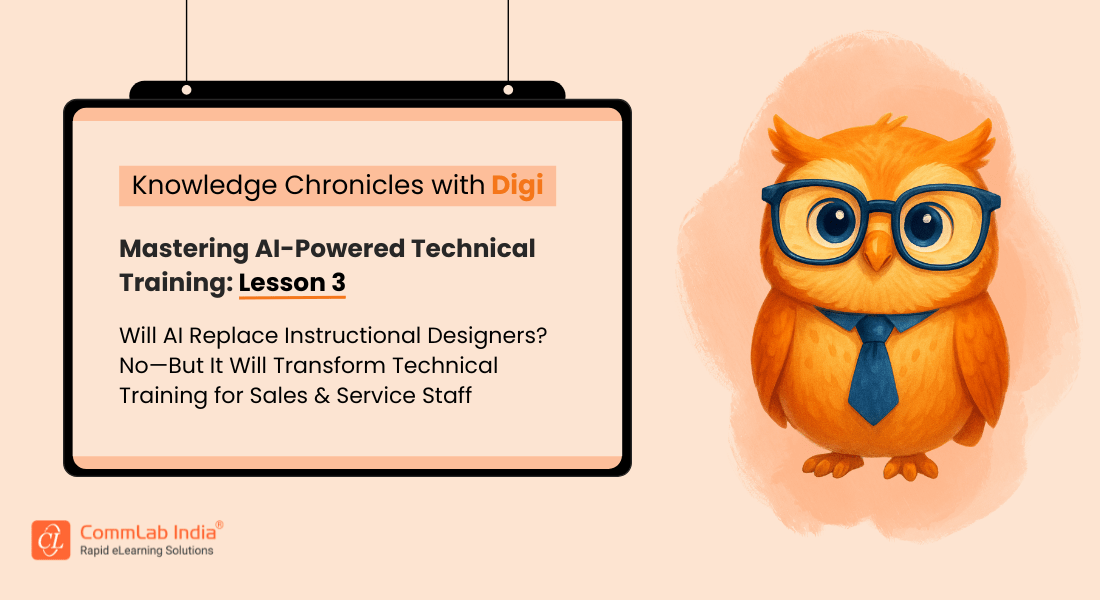Instructional Designers: Leaders of AI-Powered Technical Training

Every time a new technology wave hits, fear and hype follow. Artificial Intelligence is no exception. For Learning and Development (L&D) professionals—especially instructional designers—the big question is both exciting and unnerving: Will AI replace us?
The short answer? No. The better answer? Not if you evolve.
In the realm of technical training for sales and service staff, AI is not a replacement for instructional designers. It’s a force multiplier. A powerful assistant. And, when used strategically, a catalyst for better, faster, and more scalable learning experiences. But only if instructional designers shift their roles from content creators to performance architects.
→ Download eBook: AI-Powered Technical Training
Table Of Content
- What Are the Limitations of AI and the Strengths of Instructional Designers?
- What Is the New Role of Instructional Designers in AI-Powered Technical Training?
- Why Does This Matter in Sales and Service Training?
- How Can Field Service Training Be Transformed?
- How Can We Upskill for the AI Era?
The Limitations of AI (and the Strengths of IDs)
AI can:
- Generate content outlines
- Draft scripts or quiz questions
- Summarize SME interviews
- Translate content into multiple languages
- Create basic videos or voiceovers
Generative AI models are increasingly used for "brainstorming and content design," highlighting how AI tools enhance the instructional design process.
Source: Forbes
What AI can’t do is:
- Align training with nuanced business goals
- Determine what sales or service reps need to do (not just know)
- Design practice activities that reflect real-world judgment calls
- Apply adult learning principles with business and human insight
Instructional designers bring context, empathy, relevance, and outcome-orientation to the table—none of which AI possesses. The real opportunity is to leverage AI to accelerate the tactical work, so IDs can focus on the strategic design that truly drives performance.
The New Role of Instructional Designers in AI-Powered Technical Training
What is the New Role of Instructional Designers in AI-Powered Technical Training?
Here's how they're making an impact:
- Capture knowledge faster
- Rapidly prototype learning solutions
- Design effective learning workflows
- Facilitate collaboration with subject matter experts
In the old world, IDs often spent much of their time:
- Chasing SMEs for content
- Drafting scripts and waiting for reviews
- Building slide decks or eLearning modules from scratch
- Managing localization and revisions manually
In the new AI-powered world, IDs:
- Capture knowledge faster using AI tools to transcribe and summarize SME inputs
- Rapidly prototype video or simulation-based modules using AI tools like Vyond, Synthesia, and ChatGPT
- Design learning workflows, not just one-off courses
- Facilitate SME collaboration in structured, time-efficient ways
Want to create impactful training programs? It all starts with effective SME engagement—here’s how to get it right.
- Orchestrate reinforcement, performance support, and just-in-time learning
- Analyze data to refine and iterate training content based on engagement and application metrics

Why This Matters in Sales & Service Training
Sales and service teams are different from knowledge workers or leadership cohorts. They are:
- Often on the move or in the field
- Pressed for time
- Held accountable for metrics like conversion rates, service times, and customer satisfaction
Training for them must be:
- Task-driven and contextual
- Mobile-friendly and bite-sized
- Focused on application, not just knowledge transfer
- Launched quickly to support product updates or service rollouts
Here, the instructional designer’s role is vital:
- Mapping real-life workflows
- Creating decision-based scenarios (e.g., handling objections, resolving errors)
- Building modular microlearning paths that flex with role and region
- Ensuring reinforcement through AI-generated nudges, quizzes, or chatbot Q&A

Example: Transforming Field Service Training
Consider a global equipment manufacturer launching a new diagnostic device. They need to train:
- Sales engineers to explain the new value proposition
- Field service reps to install and calibrate it
- Customer support to troubleshoot remotely
An instructional designer working with AI tools:
- Conducts a 60-minute SME call
- Uses Fireflies to transcribe and summarize the call
- Prompts ChatGPT to draft:
- Installation checklist
- Product intro video script
- Scenario-based troubleshooting quiz
- Uses Vyond to build an animated simulation
- Uploads content to an LMS and schedules spaced-recall quizzes via MaxLearn
- Reviews learning analytics post-launch to refine weak areas
Time to launch: Under 3 weeks.
Learner satisfaction: 4.7/5.
Field support tickets: down 22%.
Upskilling for the AI Era
To thrive in this new era, instructional designers must build new muscles:
- Prompt engineering: Knowing how to get great content from AI tools
- Workflow design: Integrating tools like LMS, Qstream, Synthesia into a cohesive learner experience
- Data literacy: Understanding how to interpret dashboards, heat maps, and completion metrics to inform revisions
- Business fluency: Talking to stakeholders about performance outcomes, not just course completions
Most importantly, IDs must become curators of experience, not just developers of content.
Final Thought
AI won’t replace instructional designers. But it will replace parts of the job that are purely mechanical, repetitive, or slow.
The good news? That’s the part most IDs want to offload anyway.
The future belongs to those who can:
- Harness AI to do the heavy lifting
- Focus on designing human-centered, outcome-focused training
- Enable frontline teams to perform with confidence and clarity
In technical training for sales and service staff, the job of the instructional designer is more important—and more exciting—than ever.
Not because AI replaces them.
Because it finally frees them to do their best work.
And for technical training teams serving high-speed sales and service operations, that’s exactly the kind of impact that matters.






